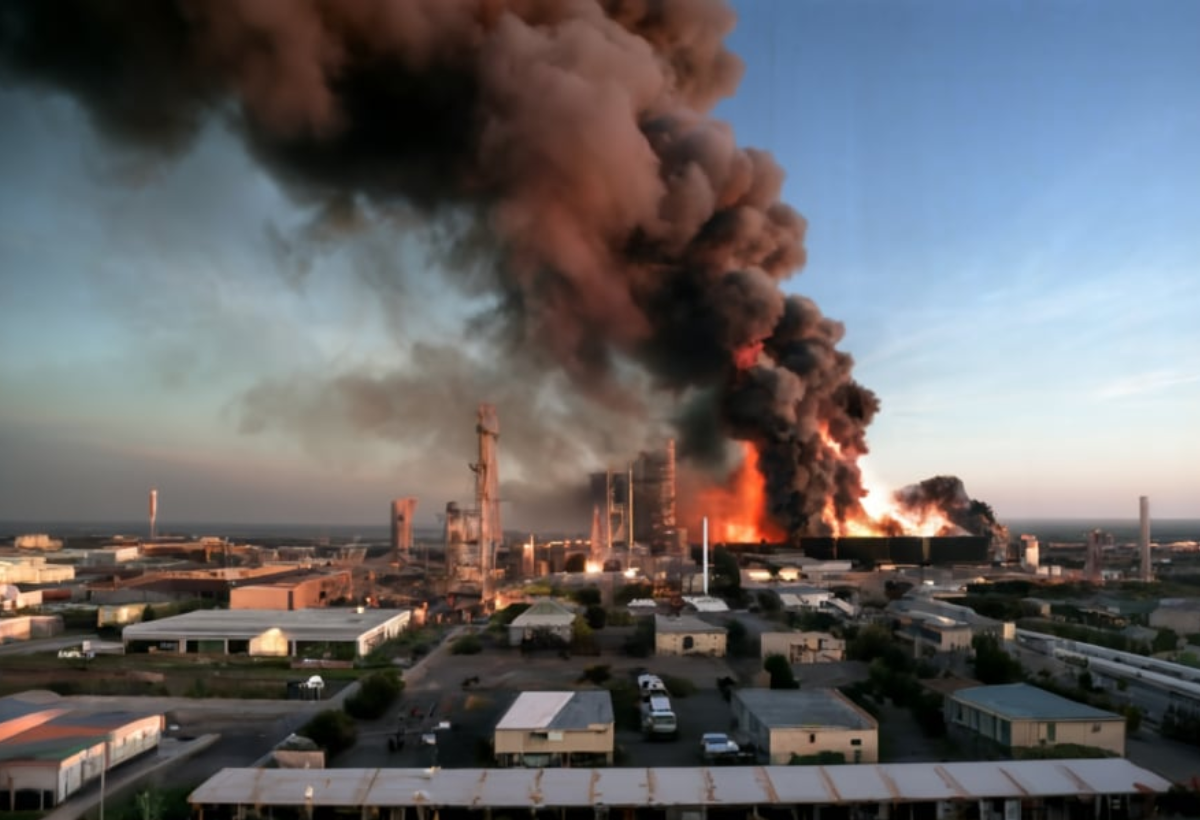The Baytown Plant Explosion of 1993, one of the most catastrophic industrial disasters in U.S. history, remains a stark reminder of the vital importance of safety in the petrochemical industry. This tragic event, which occurred in Baytown, Texas, not only shook the local community but also reverberated across the nation. The explosion, resulting from a chemical plant disaster, had significant impacts on industrial safety, environmental protocols, and corporate responsibility. In this article, we will examine the causes, aftermath, and lasting effects of the 1993 Baytown Explosion, as well as the lessons learned from this devastating event.
Introduction to the Baytown Plant Explosion
The Baytown Plant Explosion on March 23, 1993, sent shockwaves through the local community in Baytown, Texas, and beyond. This disaster was particularly notable for the combination of factors that led to such a catastrophic outcome, including a pressure buildup in chemical plants and a failure to address known risks. The explosion occurred at a large oil refinery, owned and operated by ExxonMobil (formerly Exxon), which was one of the largest chemical processing plants in the region.
The explosion registered at 4.3 on the Richter scale, an intensity usually reserved for small earthquakes, underscoring the magnitude of the disaster. As the explosion unfolded, it not only caused immense physical destruction but also posed long-term environmental risks. The Baytown explosion 1993 4.3 Richter scale was a turning point for the petrochemical industry, resulting in a reevaluation of safety practices, legal responses, and the overall approach to industrial risk management.

Background of the Baytown Plant
The Baytown Plant, located in Baytown, Texas, just outside of Houston, was one of the largest refineries and chemical plants in the United States. For decades, it had been a key facility for ExxonMobil, involved in the production of essential petrochemical products like ethylene and propylene, critical components in manufacturing plastics, synthetic rubber, and other industrial materials.
The plant, established in the 1940s, was central to both the Baytown economy and the U.S. oil and gas industry. However, due to its extensive operations involving hazardous chemicals, it had always been prone to risks associated with petrochemical accidents. Over the years, the plant had experienced numerous safety violations and equipment malfunctions, but these issues were often downplayed or insufficiently addressed, setting the stage for the disaster that would ultimately unfold in 1993.

What Happened on March 23, 1993?
On the morning of March 23, 1993, the Baytown TX explosion occurred in the Olefins Unit of the ExxonMobil plant. This unit was responsible for processing flammable chemicals, such as ethylene and propylene, and it was considered one of the most high-risk areas within the facility. The explosion was the result of a combination of factors, including a pressure buildup in chemical plants, faulty safety systems, and inadequate maintenance.
The pressure buildup had been occurring for some time, but warnings and equipment malfunctions had been overlooked or neglected. As the pressure continued to rise, the plant’s outdated safety systems failed to contain it, ultimately leading to a violent explosion. The force of the blast caused extensive damage to the plant’s infrastructure and set off a series of fires that would burn for hours, causing further destruction and loss of life.
The Immediate Aftermath of the Explosion
The immediate aftermath of the Baytown explosion 1993 was nothing short of catastrophic. The explosion left the ExxonMobil refinery in ruins, with numerous buildings collapsing under the force of the blast. Emergency response teams, including fire departments and rescue workers, were quickly deployed to contain the fires and search for survivors. Despite their efforts, the scale of the disaster was overwhelming, and Baytown residents were forced to evacuate the area due to toxic fumes and the risk of further explosions.
The explosion tragically claimed the lives of at least 23 people, including both ExxonMobil workers and emergency responders, while over 130 others were injured, many of them suffering from severe burns and other traumatic injuries. In addition to the loss of life, the explosion caused significant damage to nearby residential homes, businesses, and vehicles. Environmental contamination was another immediate concern, as hazardous chemicals were released into the air, posing long-term health risks for the local population and wildlife.
Investigating the Cause of the Explosion
Following the explosion, an explosion investigation was launched by various agencies, including the Occupational Safety and Health Administration (OSHA), the Chemical Safety Board (CSB), and the EPA. Their investigation revealed a series of failures in ExxonMobil’s safety protocols that had contributed to the disaster. These included outdated equipment, inadequate maintenance, and a lack of sufficient training for personnel to identify and address potential risks.
The Baytown explosion cause was attributed to a combination of human error and systemic failures. Despite warnings and previous incidents of pressure buildup in the Olefins Unit, these issues had not been adequately addressed. The findings pointed to a broader culture of negligence and complacency in industrial safety at the plant, with numerous safety violations being ignored or inadequately managed.
The Legal and Financial Fallout
The aftermath of the 1993 Baytown explosion was marked by a wave of lawsuits filed against ExxonMobil, with victims and their families seeking compensation for the Baytown explosion casualties. The lawsuits accused ExxonMobil of negligence, claiming that the company had failed to address known risks and had not taken sufficient precautions to prevent such a disaster.
In addition to the legal battles, the explosion resulted in significant financial fallout for ExxonMobil. The company faced not only compensation claims but also the costs of cleanup and environmental remediation efforts. The oil refinery disaster forced the plant to halt operations for an extended period, resulting in substantial financial losses for the company. The explosion also led to broader scrutiny of the petrochemical industry’s safety practices and the need for tighter regulations.
Impact on Industrial Safety Practices
The Baytown explosion 1993 had a profound impact on industrial safety practices, both within ExxonMobil and across the petrochemical industry as a whole. The disaster highlighted the dangers of inadequate safety measures and poor maintenance practices in facilities that handle volatile chemicals. As a result, the explosion prompted significant changes in safety protocols, not just within ExxonMobil but across the entire industry.
One of the key lessons learned was the need for regular maintenance and the importance of having up-to-date safety equipment in place. Additionally, the disaster underscored the importance of proper hazard analysis and emergency response planning. In the wake of the explosion, many petrochemical companies adopted more rigorous safety protocols, and there was a greater emphasis on ensuring that workers were properly trained to recognize and mitigate risks.
Environmental and Economic Consequences
The environmental impact of explosions like the Baytown explosion 1993 can be long-lasting and far-reaching. In this case, the explosion resulted in the release of hazardous chemicals into the air and surrounding areas, including nearby bodies of water. The Gulf Coast, known for its rich biodiversity, was particularly vulnerable to the environmental fallout from the disaster. Oil spills, toxic runoff, and air pollution became immediate concerns as cleanup efforts were launched to mitigate the damage.
The economic consequences of the explosion were also significant. The ExxonMobil refinery was forced to cease production for an extended period, leading to supply chain disruptions and a slowdown in the broader oil and chemical industries. Thousands of workers were displaced, and many local businesses that relied on the refinery were forced to shut down or scale back operations. The economic impact of the explosion rippled outwards, affecting not just the local community but the U.S. economy as a whole.
Legal and Regulatory Responses to the Disaster
In the wake of the Baytown explosion 1993, regulatory responses were swift and far-reaching. Federal and state agencies, including the EPA, OSHA, and the Chemical Safety Board (CSB), launched investigations into the root causes of the disaster. Their findings led to stricter safety regulations for the petrochemical and oil refinery industries, with a particular focus on equipment maintenance, chemical handling, and emergency response procedures.
The legal proceedings also brought attention to the issue of corporate responsibility in preventing industrial accidents. The lawsuits filed against ExxonMobil highlighted the company’s failure to take adequate precautions despite knowing the risks involved. These legal and regulatory responses helped to reshape the way industrial facilities approach safety, with an emphasis on transparency, accountability, and proactive risk management.
Long-Term Effects of the Baytown Explosion
The Baytown explosion 1993 had long-lasting effects on both the local community and the broader industrial landscape. For the residents of Baytown, the memory of that day remains vivid, as many lost loved ones and witnessed the destruction of their homes and businesses. In addition to the immediate loss of life and property, the explosion raised concerns about the long-term health effects of exposure to toxic chemicals for those who lived and worked near the refinery.
For the petrochemical industry, the explosion served as a wake-up call, prompting significant changes in safety protocols and regulations. Many companies implemented stricter safety standards and invested in new technologies to reduce the risk of accidents. The explosion also led to a greater focus on corporate responsibility and the need for companies to prioritize the well-being of their workers and the
Read More:- Dinsdale Shop Chair Cushions for Sale: Your Ultimate Guide to Comfort, Quality, and Style
